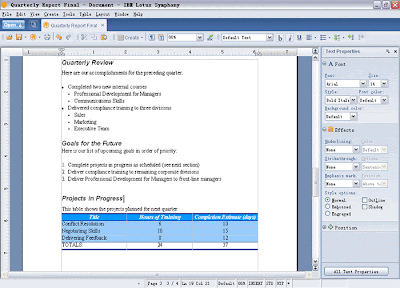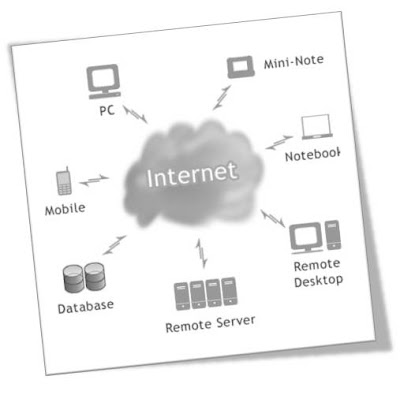Wednesday, June 23, 2010
Check your Anti Virus is Working or Not?
Just you have to follow simple instructions....
# open Notepad application and save following string as it is. this string is 68 character long
X50!P%@AP[4\PZX54(P^)7CC)7}EICAR-STANDARD-ANTIVIRUS-TEST-FILE!$H+H*
Save this file as eicar.com, if your anti-virus software stop you, then it your anti-virus softwares is doing good. Its not harmful either but if the anti virus is active it will warn you. if it does not then your anti virus is good for nothing.
For more your can check out EICAR web site
Friday, June 11, 2010
IBM Lotus Symphony
IBM Lotus Symphony is a application suite for creating, editing, and sharing text, spreadsheet, presentations and other documents, and is currently distributed as freeware.
Lotus Symphony supports platforms for Microsoft Windows, Linux and Mac OS.
Symphony consists:
- IBM Lotus Symphony Documents, (A Word Processor)
- IBM Lotus Symphony Spreadsheets,(A Spreadsheet application)
- IBM Lotus Symphony Presentations, (A Presentation application)
Document Application:

Lotus Symphony Documents supports .doc (Microsoft), .dot (Microsoft template), .docx (Microsoft Word 2007), .dotx (Microsoft Word 2007 template),.odt (ODF), .ott (ODF template), .sxw (OpenOffice.org 1.1 format), .stw (OpenOffice.org 1.1 format template), .lwp (IBM Lotus SmartSuite®), .mwp (IBM Lotus SmartSuite template), .rtf, and .txt formats
Spreadsheet Application:

Lotus Symphony Spreadsheets supports .xls (Microsoft), .xlt (Microsoft template), .xlsx (Microsoft Excel 2007), .xltx (Microsoft Excel 2007 template), .ods (ODF), .ots (ODF template), .sxc (OpenOffice.org 1.1 format), .stc (OpenOffice.org 1.1 format template), .123 (IBM Lotus Smartsuite), .12m (IBM Lotus Smartsuite template), .xml, and .csv formats
Presentation Application:

Lotus Symphony Presentations supports .ppt (Microsoft), .pot (Microsoft template), .pptx (Microsoft PowerPoint 2007), .potx (Microsoft PowerPoint 2007 template), .odp (ODF), .otp (ODF template), .prz (IBM Lotus Smartsuite), .mas (IBM Lotus Smartsuite look template), .smc (IBM Lotus Smartsuite content template), .sxi (OpenOffice.org 1.1 format), and .sti (OpenOffice.org 1.1 format template)formats.
Get more Information about symphony
Thursday, June 3, 2010
Cloud Computing

What Is Cloud Computing? Now a days I have found number of people are talking about Cloud computing. In the business world are also asking the same question, "What is Cloud Computing, and what does it mean for a business?" Cloud computing platforms are growing in popularity day by day, but why? What unique advantages does a cloud computing architecture offer to companies in today’s economic climate? Let’s explore the cloud computing infrastructure and its impact on critically important areas to IT, like security, infrastructure investments, business application development, and more. Most IT departments are forced to spend a significant portion of their time on frustrating implementation, maintenance, and upgrade projects that too often don’t add significant value to the company’s bottom line. Increasingly, IT teams are turning to cloud computing technology to minimize the time spent on lower-value activities and allow IT to focus on strategic activities with greater impact on the business. The fundamental benefits delivered by cloud computing technology.
- Web-services integration. Cloud computing technology is much easier and quicker to integrate with your other enterprise applications (both traditional software and cloud computing infrastructure-based), whether third-party or homegrown.
- A 100% cloud computing infrastructure does not need hardware or software to install. In fact it just requires significantly fewer capital expenditures to get up and running.
- Your cloud computing technology applications are live in a matter of weeks or months, even with extensive customization or integration. So, it is faster and lower-risk deployment.
- Cloud computing technology is ideal for application development to support your organization’s evolving needs and it is not difficult or impossible to customize.
- Cloud computing techology do everything for the business users that can help them to do customization, report, etc.
- As Cloud computing technology doesn’t force you to decide between upgrading and preserving all your hard work, because those customizations and integrations are automatically preserved during an upgrade.
- The Force.com AppExchange features hundreds of applications built for cloud computing infrastructure, pre-integrated with your Salesforce CRM application or your other application development work on Force.com.
- Amazon Elastic Compute Cloud (EC2)
- Google App Engine
- Force.com
- GoGrid
- Azure
- Intuit Partner Platform (IPP)
Refrence link
http://en.wikipedia.org/wiki/Cloud_computing
Windows Management Instrumentation Command
Read a huge range of information about local or remote computers. Also provides a way to make configuration changes to multiple remote machines.
Syntax
WMIC [global switches] [/locale:ms_409] alias> [options][format]
What is WMIC?
WMIC extends WMI for operation from several command-line interfaces and through batch scripts. Before WMIC, people used WMI-based applications (such as SMS), the WMI Scripting API, or tools such as CIM Studio to manage WMI-enabled computers. Without a firm grasp on a programming language such as C++ or a scripting language such as VBScript and a basic understanding of the WMI namespace, do-it-yourself systems management with WMI was difficult. WMIC changes this situation by giving you a powerful, user-friendly interface to the WMI namespace.
WMIC is more intuitive than WMI, in large part because of aliases. Aliases take simple commands that you enter at the command line, then act upon the WMI namespace in a predefined way, such as constructing a complex WMI Query Language (WQL) command from a simple WMIC alias Get command. Thus, aliases act as friendly syntax intermediaries between you and the namespace. For example, when you run a simple WMIC command such as
useraccount list brief
from the WMIC command prompt to get user account information, the Useraccount alias performs a WQL query of the Win32_Useraccount class and displays specific data from this class in text format. WMIC also displays the Win32_Useraccount class's properties at the console in text format. WMIC can return the results of a command in other formats, such as XML, HTML, and Comma Separated Value (CSV).
How to Run WMIC
To invoke the WMIC command prompt, type
wmic
in the standard XP or .NET Server command interpreter (cmd.exe), a Telnet session, or the Run dialog box. These startup methods are available locally or through a .NET Server Terminal Services session.
The first time you start WMIC, Windows installs it on the computer and displays the WMIC command prompt, wmic:root\cli>. At this prompt, you enter commands interactively. For example, the command
process where name='outlook.exe' call terminate
closes Microsoft Outlook if it's running. After the command runs, the WMIC command prompt reappears. Note that you must type each command in this article on one line, not split across multiple lines, for the commands to run properly. (Some commands in the tables and listings in this article are split across multiple lines for publication purposes.)
WMIC also runs in noninteractive mode. This mode is especially useful when you need to complete a single task or you need to run WMIC commands in a batch file. To run a command in noninteractive mode, you start WMIC and run the command in the same line of code. For example, you can open a command prompt and type
wmic /node:SERVER1 printer list status
to check the status of printers attached to SERVER1. In this example, WMIC starts, uses the /node switch to establish a remote connection to SERVER1, and runs a command to display printer status information. After the command runs and displays results, the command prompt reappears.
You can remotely access any WMI-enabled computer from any computer running WMIC. The computer you want to access doesn't require WMIC. For example, you can start WMIC from a computer running XP Professional Edition to manage a mix of computers running XP, Win2K, Windows NT 4.0, Windows Me, and Windows 9x.
WMIC Command-Line Components
WMIC uses global switches, aliases, verbs, commands, and command-line help to empower the interface. Global switches are settings that apply to and for the entire WMIC session. For example, the /trace:on switch enables error tracing. While this switch is on, WMIC returns error information for every command you execute. The /node switch lets you access a remote computer. The /interactive:on switch ensures that WMIC prompts you for confirmation before performing delete operations. Other global switches include /role, /user, /implevel, and /namespace.
Reference link
http://msdn.microsoft.com/en-us/library/Aa394572
http://msdn.microsoft.com/en-us/library/aa394531%28VS.85%29.aspx
http://support.microsoft.com/servicedesks/webcasts/wc072402/listofsampleusage.asp
http://ss64.com/nt/wmic.html
Wednesday, June 2, 2010
Find PC or Laptop Serial Number with DOS Command
Many times I have heard about the problem, that people have the Laptop/Desktop from the manufactures like DELL, IBM, etc. and they come with serial number or service tag and model name. If they ever loose this information then how can get to know about it.
Way 1, is to find from the box. Way 2 is the sticker on your PC/Laptop. and Way 3 to know from DOS. Yes, from DOS.
Here is the simple way to find serial number using DOS Command.
c:\> wmic bios get serialnumber
To retrieve model name of the computer run the following command
c:\>wmic csproduct get name
So Net time you don't have to worry about finding SR#..... enjoy.
Tuesday, June 1, 2010
Office 2010 - A Closer Look
Office 2010 can help you to get things done, smoother then ever.

In new version of Office 2010, there are manay features available that can be used in cross applications.
Some of the best features that can be find in application are:
- Edit Pictures with New and Improved functionality
- Give artistic effects to contents, that was just possible with Word Art only in earlier versions.
- Preview the formating before you apply
- New feature to insert screenshot in your open windows directly from Office
- Co-Authoring is the new features (Edit document at the same time working with other people i.e. multi-editing function)
- Now you can insert videos from website and also you can trim videos
- With the help of new web apps you can now use office tools on internet browser. With some of the same formatting and editing tools that you know in office client installed in your PC
- Many more...
Ethical Hacking
Introduction to Ethical Hacking.
- It is a part of your ongoing security Architecture.
- It is an art and science of determining the vulnerabilities of your information infrastructure to better defend, used to determine the weaknesses in your network BEFORE the real hackers do!
- It is been performed by highly skilled, ETHICAL security professionals (We also know them as White Collared Hackers), uses the same techniques and tools to find the weaknesses and mitigate them or defend against them.
Types of Ethical Hacking
- White Box: You have FULL knowledge of the network
- Black Box: You have NO knowledge of the infrastructure
- Gray Box: You have some knowledge of the network
Assessment Testing:
- Vulnerability Assessment, using an automated tool to identify weaknesses or vulnerabilities in a network
- Penetration testing, Comprehensive review of vulnerabilities, how to exploit them, how network reacts to them
some more details will be added soon....
